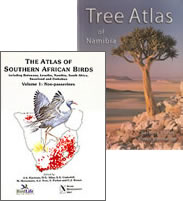Flora
The landscape comprises almost entirely a mosaic of tree and shrub savanna. Waterberg plateau has one of the highest levels of plant diversity in Namibia, with over 500 species recorded. Bush encroachment is evident throughout the landscape.
Trees
Approximately 60 tree species are known from the Waterberg Plateau Park and 139 species have been recorded from the whole landscape. The plateau features broad-leaved tree shrub savanna habitat dominated by Terminalia sericea, Burkea africana, Combretum collinum, C. psidioides and Peltophorum africanum. Isolated grass savanna valleys are dominated by Anthephora pubescens and Eragrostis superba. A dense Acacia shrub, A. mellifera detinens, is found below the plateau. Flame lily Gloriosa superba, white bauhinia Bauhinia petersiana, the quasi endemic Cheilanthes dinteri and ten fern species are found, including Microlepia speluncae.
Grasses
It is estimated that up to 74 species of grasses occur in this area of Namibia.
Relevant literature
-
Information on African Wild Dog Conservancy
Information on African Wild Dog Conservancy from NACSO website
Fact sheets, notice-board posters etc on African Wild Dog Conservancy» Download -
Information on Okamatapati Conservancy
Information on Okamatapati Conservancy from NACSO website
Fact sheets, notice-board posters etc on Okamatapti Conservancy» Download -
Information on Otjituuo Conservancy
Information on Otjituuo Conservancy from NACSO website
Fact sheets, notice-board posters etc on Otjituuo Conservancy» Download -
Information on Ozonahi Conservancy
Information on Ozonahi Conservancy from NACSO website
Fact sheets, notice-board posters etc on Ozonahi Conservancy» Download -
Vegetation of the eastern communal conservancies in Namibia. Part 1
Strohbach BJ 2014. Vegetation of the eastern communal conservancies in Namibia: I. Phytosociological descriptions, Koedoe 56(1), Art. #1116, 18 pages
The establishment of communal conservancies aims to have the local communities share in the benefits especially of wildlife resources, in this way spearheading the conservation of the environment. The Desert Margins Programme in Namibia aimed to develop vegetation resource data for the Otjituuo, Okamatapati, Ozonahi, African Wild Dog, Otjinene, Epukiro, Otjombinde, Omuramba Ua Mbinda, Eiseb and Ondjou communal conservancies, in order to assist with natural resource planning. For this purpose, a phytosociological survey of this area, with 422 relevés, was conducted during 2004. Thirteen vegetation associations were formally described in this article, of which two were subdivided into subassociations. These associations can broadly be grouped into broad-leaved savanna types typical of the central and northern Kalahari of Namibia and microphyll savannas found on the transitions to the Central Plateau. Threats to the vegetation include overutilisation and regular fires, both of which could easily lead to desertification. This threat is aggravated by global climate change.» Download -
Vegetation of the eastern communal conservancies in Namibia. Part 2
Strohbach BJ 2014. Vegetation of the eastern communal conservancies in Namibia: II. Environmental drivers, Koedoe 56(1), Art. #1117, 12 pages
The eastern communal conservancies are situated along the western fringe of the Kalahari basin. Under a very short rainfall gradient, the vegetation abruptly changes from microphyllous Acacia-dominated savannas to mesophyll savannas, dominated by Terminalia sericea and Combretum spp. We hypothesise that this is caused by changes in soil moisture availability brought about by changes in soil texture from loamy soils to deep sands (the ‘inverse texture effect’). For this analysis, we used vegetation and soils data derived from a recognisance survey of the natural resources of the study area. As the sites in the soil and vegetation surveys did not overlap, it was decided to use only synoptic data for the plant associations in the analysis. Non-metric multidimesional scaling ordination was utilised as ordination technique of the vegetation data and various environmental parameters, including soil texture, soil hydraulic parameters, climatic and fire regime parameters, were overlaid as biplots onto the resulting graph, as were various plant functional attributes particularly related to climatic conditions. The main environmental gradient identified within the study area is the rainfall gradient. This relatively short gradient, however, does not explain the marked change in vegetation observed within the study area. This change is attributed to the change in soil type, in particular, the soil texture and the associated soil hydraulic parameters of the soil. This gradient is closely correlated to leaf size, explaining the change from microphyll savannas to mesophyll savannas along the change from loamy to sandy soils. One of the lesser understood mechanisms for the survival of these mesophyll plants on sandy soils seems to be a deep root system, which is actively involved in water redistribution within the soil profile – by hydraulic lift, inverse hydraulic lift and stem flow.» Download -
Waterberg Plateau Park
Ministry of Environment and Tourism. Waterberg Plateau Park
6 page brochure describing the park and its attractions» Download




